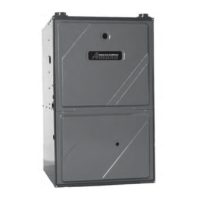28
NOTE: If measuring gas pressure at the drip leg, a field supplied
hose barb fitting must be installed prior to making the hose
connection. If using the inlet pressure boss on the gas valve,
then use the 36G Valve Pressure Check Kit, Goodman Part No.
0151K00000S.
3. Turn ON the gas supply and operate the furnace and all
other gas consuming appliances on the same gas supply
line.
4. Measure furnace gas supply pressure with burners firing.
Supply pressure must be within the range specified in the
Inlet Gas Supply Pressure table.
Natural Gas
Minimum: 5.0" w.c. Maximum:10.0" w.c.
Propane Gas
Minimum: 11.0" w.c. Maximum:13.0" w.c.
Inlet Gas Supply Pressure
If supply pressure differs from table, make the necessary adjust-
ments to pressure regulator, gas piping size, etc., and/or consult
with local gas utility.
5. Turn OFF gas to furnace at the manual shutoff valve and
disconnect manometer. Reinstall plug before turning on
gas to furnace.
6. Turn OFF any unnecessary gas appliances started in step
3.
GAS MANIFOLD PRESSURE MEASUREMENT AND ADJUSTMENT
CAUTION
T
O PREVENT UNRELIABLE OPERATION OR EQUIPMENT DAMAGE, THE GAS
MANIFOLD PRESSURE MUST BE AS SPECIFIED ON THE UNIT RATING PLATE.
O
NLY MINOR ADJUSTMENTS SHOULD BE MADE BY ADJUSTING THE GAS VALVE
PRESSURE REGULATOR.
Only small variations in gas pressure should be made by adjust-
ing the gas valve pressure regulator. The manifold pressure must
be measured with the burners operating. To measure and adjust
the manifold pressure, use the following procedure.
1. Turn OFF gas to furnace at the manual gas shutoff valve
external to the furnace.
2. Turn off all electrical power to the system.
3. Back outlet pressure test screw (inlet/outlet pressure boss)
out one turn (counterclockwise, not more than one turn).
4. Attach a hose and manometer to the outlet pressure boss
of the valve.
5. Turn ON the gas supply.
6. Turn on power and energize main (M) solenoid. Do not
energize the (HI) solenoid.
7. Measure gas manifold pressure with burners firing. Adjust
manifold pressure using the Manifold Gas Pressure table
shown below.
8. Remove regulator cover screw from the low (LO) outlet
pressure regulator adjust tower and turn screw clockwise
to increase pressure, or counterclockwise to decrease
pressure.
9. Energize main (M) solenoid as well as the (HI) terminal.
10. Remove regulator cover screw from the (HI) outlet pressure
regulator adjust tower and turn screw clockwise to increase
pressure, or counterclockwise to decrease pressure.
11. Turn off all electrical power and gas supply to the system.
12. Remove manometer hose from outlet pressure boss.
13. Turn outlet pressure test screw in to seal pressure port
(clockwise, 7 in-lb minimum).
14. Turn on electrical power and gas supply to the system.
15. Turn on system power and energize valve.
16. Using a leak detection solution or soap suds, check for
leaks at pressure boss screw. Bubbles forming indicate a
leak. SHUT OFF GAS AND FIX ALL LEAKS IMMEDIATELY.
NOTE: For gas to gas conversion, consult your dealer for
appropriate conversion.
Gas Rate Range Nominal
Low Stage 1.7 to 2.3" w.c. 2.0" w.c.
High Stage 3.2 to 3.8" w.c. 3.5" w.c.
Low Stage 5.7 to 6.3" w.c. 6.0" w.c.
High Stage 9.7 to 10.3" w.c. 10.0" w.c.
Manifold Gas Pressure
Natural
Propane
GAS INPUT RATE MEASUREMENT (NATURAL GAS ONLY)
The gas input rate to the furnace must never be greater than that
specified on the unit rating plate. To measure natural gas input
using the gas meter, use the following procedure.
1. Turn OFF the gas supply to all other gas-burning appliances
except the furnace.
2. While the furnace is operating, time and record one
complete revolution of the smallest gas meter dial.
3. Calculate the number of seconds per cubic foot (sec/ ft
3
) of
gas being delivered to the furnace. If the dial is a one cubic
foot dial, divide the number of seconds recorded in step 2
by one. If the dial is a two cubic foot dial, divide the number
of seconds recorded in step 2 by two.
4. Calculate the furnace input in BTUs per hour (BTU/ hr). Input
equals the installation’s gas heating value multiplied by a
conversion factor (hours to seconds) divided by the number
of seconds per cubic foot. The measured input must not be
greater than the input indicated on the unit rating plate.
EXAMPLE:
Installation’s gas heating (HTG) value: 1,000 BTU/ft
3
(Obtained from gas supplier)
Installation’s seconds per cubic foot: 34 sec/ ft
3
Conversion Factor (hours to seconds): 3600 sec/hr
Input = (Htg. value x 3600) ÷ seconds per cubic foot
Input = (1,000 BTU/ft
3
x 3600 sec/hr) ÷ 34 sec/ ft
3
Input = 106,000 BTU/hr
This measured input must not be greater than the input
indicated on the unit rating plate.
5. Turn ON gas and relight appliances turned off in step 1.
Ensure all the appliances are functioning properly and that
all pilot burners are operating.
TEMPERATURE RISE
Temperature rise must be within the range specified on the unit
rating plate. An incorrect temperature rise may result in condens-
ing in or overheating of the heat exchanger. An airflow and tem-
perature rise table is provided in the Product Data Book applicable
to your model. Determine and adjust temperature rise as follows:

